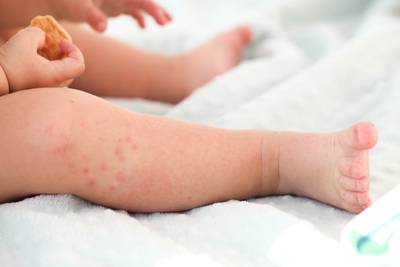Understanding Different Types of Baby Rashes

“Smooth as a baby’s bottom” is a common saying, and we think of babies as having perfect, smooth skin. So if you find scaly dry patches or tiny red bumps on your little one, you might feel a little alarmed.
Don’t worry, though: by knowing the symptoms and treatments (and by getting help when necessary) you can comfort and soothe your baby’s itchy skin. From eczema to that pesky diaper rash, here are some pediatric skin conditions that might be giving your little one grief.
Pediatric Skin Condition: Eczema
What it is: Around 20% of young children develop eczema, most within the first year of their life. Plus, 60% of babies with eczema will have the condition as an adult – which means you probably want to start getting treatment for your kiddo early.Eczema (atopic dermatitis) can show up anywhere on your baby’s skin, but it’s most common on the scalp, arms, legs, and chest. Children as young as three or four months can develop it. In children older than one year, it shows up most often inside the elbows, on the backs of the knees, and on the ankles and wrists. Eczema usually looks like dry, red skin, sometimes with small red bumps. It tends to come and go, flaring up from time to time and then subsiding for a while.
How to treat it: Even though eczema isn’t an allergic reaction, certain irritants like wool and fragrances can trigger flare-ups. So you might want to try minimizing your baby’s contact with wool and synthetic fibers. Cotton and fine linen are safe, comfy alternatives. Don’t dress your baby in too many layers, and use light, soft bedding and clothing.When bathing your child, use mild, fragrance-free soap and gently pat your baby’s skin with a soft towel afterward (rather than rubbing). Apply ointment or cream to the skin after each bath. When you’re washing your child’s clothes, use a fragrance-free detergent and steer clear of fabric softeners.You also want to keep your little one from scratching. Eczema can get itchy, but scratching will just make it worse. Plus, it will lead to scarring. If your child keeps scratching, you may need to put cotton mittens or socks on his or her hands before bed. And keep the baby’s nails short so he or she can’t do too much damage.Dry weather, temperature changes, and stress can also trigger flare-ups. While you may not be able to do much about these triggers, it’s still good to be aware. And there are certain things you can try to reduce your baby’s stress.If your little one seems stressed out, try giving him or her more physical affection. Just don’t overdo it – your baby will usually let you know when he or she has had enough together time. Watch for signs like covering the face, turning the head away, or squirming.Try walking around while carrying your baby. In a recent study, researchers found that babies experience slower heart-rates, less body movement, and less crying while being carried around.
Put your child to bed as soon as he or she starts looking drowsy. Use a soothing bedtime routine and devote all your attention to your little one as you get him or her ready for bed. Finally, since babies can pick up on their parents’ stress, try not to let your own anxiety wear off on your little one.
If your child seems to have frequent eczema flare-ups, you may want to start keeping a notepad or journal handy so you can write down any triggers that seem to irritate your baby’s skin.
Of course, if you notice your baby’s skin is looking rather dry and red, or if your baby seems to be scratching a lot, you’ll probably want to take them to a dermatologist. That way, you can get a professional opinion and find out specifically what your baby needs for healthier, smoother skin.
Your pediatric dermatologist may prescribe steroid cream for you to apply to your baby’s skin once or twice a day. When used for too long or at too high of a strength, steroid creams can be harmful, which is why you’ll need to get a prescription and instructions from your child’s dermatologist. Rest assured, though, when used correctly, steroid cream won’t harm your little one – only help.
Sometimes, a dermatologist will also prescribe antihistamine to reduce your little one’s itching at night. Or he or she may suggest that you put mittens on your baby’s hands or change to a different soap.
Since the triggers and treatments for eczema vary from person to person, your baby’s dermatologist may give you slightly different advice. In any case, getting help for your little one now will help you prevent infection and start managing your child’s eczema sooner rather than later. That means greater health and comfort for your baby now and further down the road.
Pediatric Skin Condition: Diaper Rash
What it is: While your baby may or may not develop eczema, chances are you’ll have to deal with diaper rash at some point. You’ll recognize it by the red, tender-looking skin in the diaper area. Diaper rash is usually only a problem for children under one year old, who have especially tender skin.
How to treat it: The best way to treat diaper rash is to change your baby’s diaper often and let his or her bottom air out from time to time (which means forgoing the diaper and letting the kiddo roam free for about ten minutes). You can also use petroleum jelly or a cream that contains zinc oxide on that cute little bum.
Pediatric Skin Condition: Heat Rash
What it is: When your little one gets overheated or sweaty, you might notice small red bumps on his or her back, neck, face, or bottom.Heat rash (also known as prickly heat or miliaria) can happen anytime a baby gets too hot. This might happen when the weather is humid or when the baby is wearing too many layers. That soft, fragile skin just doesn’t regulate heat very well.
How to treat it: The good news is heat rash is easy to take care of. Just cool that baby off. Swap out all those layers for some light, cotton clothing. Move your baby to a room with a cooler temperature (if possible). Or try a nice, cool bath. The rash should go down in about half an hour.
Pediatric Skin Condition: Cradle Cap
What it is: Cradle cap (or seborrheic dermatitis) is basically baby dandruff. You might see tiny flakes, red bumps, or crusty, yellowish scales on your baby’s head.
How to treat it: While it may look a little alarming, cradle cap is nothing to worry about. Common during a baby’s first three months, it’s pretty harmless. If you’re concerned, you can use mineral oil or petroleum jelly to massage your baby’s scalp, or you can take your baby to a dermatologist and get some pointers on which shampoos to use.
Don’t let red bumps or itchy skin alarm you – just keep an eye out. With the right amount of TLC, that little one will be all healthy and happy again.
